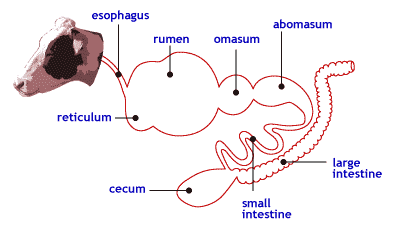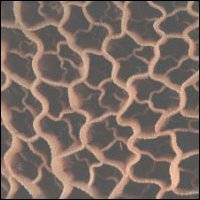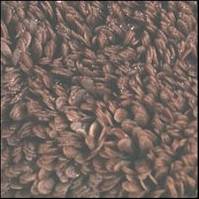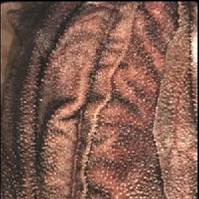Previous Page | Right click this page to print.
Species Specifics
Audio transcript; narrated by Annette Buyserie, Oregon State University
The avian and ruminant species have GI tract variations warranting further discussion as they influence the diet consumed and utilization efficiency.
The avian species have variations throughout their GI tract. Figure
1.6 illustrates the general features of the poultry GI tract.  Poultry
do not have teeth. Poultry use their beak and claws to reduce the particle
size of the feed so the feed may be swallowed and digested. The stomach
of the avian species is divided into three regions. The first region is
the crop. The crop functions as a temporary storage for consumed feed.
The second region is the proventriculus. The proventriculus is the glandular
stomach of the avian species. The functions are similar to the previously
discussed functions of the glandular stomach. The third region is the
gizzard. The gizzard is a dense pouch containing a tough, muscular lining.
The interior of the gizzard contains grit or small stones. Via muscular
contractions, the gizzard grinds ingested feed. Located subsequent to
the small intestine, the avian species have two large ceca. Finally, the
avian species have one excretory duct therefore their excrement is a combination
of both feces and urine.
Poultry
do not have teeth. Poultry use their beak and claws to reduce the particle
size of the feed so the feed may be swallowed and digested. The stomach
of the avian species is divided into three regions. The first region is
the crop. The crop functions as a temporary storage for consumed feed.
The second region is the proventriculus. The proventriculus is the glandular
stomach of the avian species. The functions are similar to the previously
discussed functions of the glandular stomach. The third region is the
gizzard. The gizzard is a dense pouch containing a tough, muscular lining.
The interior of the gizzard contains grit or small stones. Via muscular
contractions, the gizzard grinds ingested feed. Located subsequent to
the small intestine, the avian species have two large ceca. Finally, the
avian species have one excretory duct therefore their excrement is a combination
of both feces and urine.
Figure 1.7 illustrates the general features of a ruminant GI tract.

The ruminant species possess one significant variation in their GI tract. The ruminant species have one stomach that is divided into four compartments.

Figure 1.8 illustrates the orientation and relative sizes of the four compartments. The first compartment is the reticulum. The feed travels from the esophagus into the reticulum.
 Figure
1.9 is a photograph of the interior surface of a bovine reticulum. Note
the honeycomb appearance. The function of the reticulum is to capture
and retain dense particles. In addition, the reticulum is a site of microbial
fermentation. As stated previously, the reticulum and the rumen are not
completely separate and therefore feed moves relatively freely between
the two compartments. Following rumen development, the rumen is the largest
of the four compartments. The rumen is the site of the extensive microbial
fermentation. The microbial population consists of bacteria, protozoa,
and fungi. Dietary feedstuffs and dry matter intake influence the relative
proportions and absolute amounts of the classes of microorganisms. As
the system is located before both the ruminant’s digestive and absorptive
compartments, the utilization efficiency of the products of microbial
fermentation are maximized. Figure 1.10 is a photograph of the interior
Figure
1.9 is a photograph of the interior surface of a bovine reticulum. Note
the honeycomb appearance. The function of the reticulum is to capture
and retain dense particles. In addition, the reticulum is a site of microbial
fermentation. As stated previously, the reticulum and the rumen are not
completely separate and therefore feed moves relatively freely between
the two compartments. Following rumen development, the rumen is the largest
of the four compartments. The rumen is the site of the extensive microbial
fermentation. The microbial population consists of bacteria, protozoa,
and fungi. Dietary feedstuffs and dry matter intake influence the relative
proportions and absolute amounts of the classes of microorganisms. As
the system is located before both the ruminant’s digestive and absorptive
compartments, the utilization efficiency of the products of microbial
fermentation are maximized. Figure 1.10 is a photograph of the interior
 surface
of the rumen. The projections on the interior surface of the rumen are
the rumen papillae. The papillae function to increase the surface area
and therefore absorption efficiency of the rumen. The rumen papillae function
similarly to the villi of the small intestine. From the reticulorumen
feed travels to the omasum. Figure 1.11 is a photograph of the interior
of the omasum.
surface
of the rumen. The projections on the interior surface of the rumen are
the rumen papillae. The papillae function to increase the surface area
and therefore absorption efficiency of the rumen. The rumen papillae function
similarly to the villi of the small intestine. From the reticulorumen
feed travels to the omasum. Figure 1.11 is a photograph of the interior
of the omasum. The omasum has many membranous leaves that extend into the lumen. The
function of the omasum is to sieve large particles and therefore regulate
passage of feed to the abomasum. In addition, the omasum also functions
in water absorption. From the omasum, the feed will travel to the abomasum.
The abomasum is the ruminant’s glandular stomach. The abomasum is
the largest compartment in the newborn ruminant.
The omasum has many membranous leaves that extend into the lumen. The
function of the omasum is to sieve large particles and therefore regulate
passage of feed to the abomasum. In addition, the omasum also functions
in water absorption. From the omasum, the feed will travel to the abomasum.
The abomasum is the ruminant’s glandular stomach. The abomasum is
the largest compartment in the newborn ruminant.
As a consequence of the ruminant system, there are a number of characteristics unique to the ruminant species. As previously stated, newborn ruminants do not have a functional rumen. However, the rumen does have a microbial population. The environment of the rumen influences their diet and means of digestion. Young ruminants have a reticular or esophageal groove. As the young ruminant consumes milk, the reticular groove forms a tube between the esophagus and the omasum. The consumed milk travels directly from the esophagus to the omasum. The high-quality milk escapes rumen fermentation and the utilization of nutrients is maximized in the digestion and absorption of the abomasum and small intestine. Rumen development proceeds with consumption of solid feeds. The solid feeds are consumed by the animal and initially digested in the rumen. The resultant production of volatile fatty acids (VFA) stimulates rumen development. Diet influences the rate of rumen development. The reticulum and rumen will be completely developed at 8 weeks in lambs and 6 to 9 months in calves.
Two processes essential to the ruminant species are rumination and eructation. Rumination is the process of bolus regurgitation and remastication. The function of rumination is to reduce particle size, therefore aiding in digestion. Eructation is the process of emission of fermentation gases such as carbon dioxide and methane. Accumulation of rumen fermentation gases will lead to bloat and serious cases may lead to death.
Rumen fermentation has a number of advantages and disadvantages that influence the feedstuff consumed and subsequent utilization efficiency. The first advantage of rumen fermentation is the relatively efficient utilization of fibrous feedstuffs, such as forages, by the ruminant. The rumen microbial population has the ability to metabolize fibrous components such as hemicellulose and cellulose, to products such as acetate, propionate, and butyrate also known as the primary volatile fatty acids of rumen fermentation. The ruminant then metabolizes the VFA to produce energy. Another advantage is the relatively efficient utilization of lower quality protein and non-protein nitrogen compounds also known as NPN compounds. The microbial population metabolizes the lower quality proteins and NPN compounds to a higher quality microbial crude protein (MCP). Upon the microbes pass to the abomasum and small intestine, the higher quality MCP is digested and absorbed. The synthesis of MCP is a complex process that depends on such factors as nitrogen and energy substrates and intake. One final advantage, as previously stated, is the microbial production of the water-soluble vitamins and vitamin K. Except for the highest producing ruminants, the amount produced fulfills the dietary requirements for those vitamins. The first disadvantage of rumen fermentation is the relatively low utilization efficiency of higher quality feedstuffs. Rumen fermentation reduces the potential energy yield from digestible energy sources and reduces the quality of high quality protein.
Previous Page | Right click this page to print.